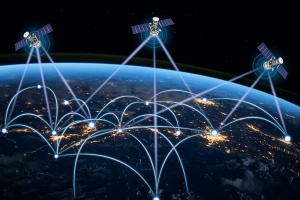Can Satellites Enable the Next Phase of Advanced Secure Networking?
by Michael Cubeddu
There were approximately 11,330 individual objects orbiting the earth in 2023, according to the United Nations Office for Outer Space Affairs Index of Objects Launched into Outer Space, with more than 8,370 active satellites in various Earth orbits at the beginning of 2024. These satellites are critical in providing global connectivity for the applications that power our everyday lives (GPS, wifi, banking, radio to name just a few) and will play a pivotal role in scaling advanced secure networks and the next phase of a more secure and versatile Internet beyond the constraints of terrestrial fiber networks.
 Today’s satellite communications consists of an uplink stage (where transmission from ground station to designated satellite occurs), a transponder stage (where the satellite does signal amplification and frequency change, and the downlink stage (when transmission goes back to the ground station or stations from the satellite). Different frequency bands, beam types and orbits are also used for different types of applications.The vast majority of today’s satellite communication systems leverage the radio frequency band because it’s more reliable and better for longer distances. Interest has been growing, though, in using free-space optical (FSO) communications for higher-bandwidth applications at short to mid-range distances, extending the reach of existing entanglement-based advanced secure networks. These applications could include modern secure communications, secure access to cloud and generative AI LLMs, data, and algorithms, and secure networking of quantum computers. By encoding quantum states into photons for communication, free-space quantum communication is achieved.
Today’s satellite communications consists of an uplink stage (where transmission from ground station to designated satellite occurs), a transponder stage (where the satellite does signal amplification and frequency change, and the downlink stage (when transmission goes back to the ground station or stations from the satellite). Different frequency bands, beam types and orbits are also used for different types of applications.The vast majority of today’s satellite communication systems leverage the radio frequency band because it’s more reliable and better for longer distances. Interest has been growing, though, in using free-space optical (FSO) communications for higher-bandwidth applications at short to mid-range distances, extending the reach of existing entanglement-based advanced secure networks. These applications could include modern secure communications, secure access to cloud and generative AI LLMs, data, and algorithms, and secure networking of quantum computers. By encoding quantum states into photons for communication, free-space quantum communication is achieved.
Advanced Secure Networks are based on entanglement making them inherently secure with the ability to replace the RSA public key exchange models and mitigate vulnerabilities presented from Harvest Now Decrypt Later (HNDL) and sophisticated man-in-the-middle attacks. These new networks enable an incremental upgrade to existing encrypted virtual private networks used to secure Enterprise, service provider, and government connections carrying an organization’s most sensitive data, voice, and video information (i.e., customer information, financial details, intellectual property, private transactions, and nation secrets). Because these modern networks transmit information using qubits, not bits, they also support advanced applications such as quantum computers and sensors.
Use Cases for Satellite Entanglement-based Communications
New Advanced Secure Networks based on entanglement will use a combination of terrestrial networks on the ground and segments based in space, and can be used for applications like entanglement distribution, access to quantum computing, and networking of distributed quantum sensors. For example, two satellites, each with an entangled photon pair source, can emit a pair of photons. They each send one photon to a ground station and another photon to the middle node (the terrestrial repeater node). This middle node captures the incoming photons, one photon from each pair emitted by the two satellites, and then performs entanglement swapping. This process effectively stitches together the entanglement from the first ground stations to the middle node with the entanglement from the last ground station to the middle node, creating long-range entanglement between the two ground stations. This is one method for delivering entanglement to very distant ground stations using satellite downlinks. Uplinks could also be used to emit the entangled photon pair to a satellite hosting a quantum repeater.
Applications, tolerance to latency, field of view, and organizational budgets will dictate the requirements for which architecture is chosen, as well as expected advancements in advanced secure network hardware and protocols.
Progress to date
There are a number of entanglement-based network satellite efforts currently taking place. The first demonstration of free-space entanglement distribution occurred in 2005, a terrestrial demonstration of entanglement distribution over 13 km. Since then, a number of projects including government agencies, private companies, satellite companies, startups, large corporations and universities, have kicked off.
QEYSSat (Quantum EncrYption and Science Satellite) , driven by the Canadian Space Agency, plans to launch three Low Earth Orbit satellites to study, demonstrate, and validate space-based quantum secure communications. QKDSat (Quantum Key Distribution Satellite) launched in 2023 and aims to demonstrate how a space-based quantum infrastructure can be used to exchange sensitive information between several parties. China’s Shenzhou 16 project launched in 2023 and plans to launch a Geostationary satellite in 2026. SpooQySats projects, led by the National University of Singapore Center for Quantum Technologies, in collaboration with a company called SpeQtral, launched in 2018 and 2020 to demonstrate entanglement generation on a satellite. The Deep Space Quantum Link project, led by NASA, aims to establish long-baseline quantum links between the Lunar Gateway moon-orbiting space station and nodes on, or near, the Earth. These examples are by no means exhaustive, but do demonstrate the breadth of interest and geographic scope.
Free-space entanglement-based networking will scale small local area networks and metropolitan scale terrestrial networks to achieve a global entanglement-based Internet, and enable a host of new applications we haven’t even dreamt of yet.
-----------------
 Michael Cubeddu is the Co-Founder and VP of R&D at Aliro where he focuses on research, IP, and customer and partner relations. Michael is a published author in quantum research, and a co-inventor of several patents in quantum computing software, error correction, and quantum network protocols -- all driving deployment of commercial-grade product lines at Aliro. He is actively involved in the Quantum Economic Development Consortium.and serves as the liaison between the QED-C and the ITU-T for quantum key distribution standards development.
Michael Cubeddu is the Co-Founder and VP of R&D at Aliro where he focuses on research, IP, and customer and partner relations. Michael is a published author in quantum research, and a co-inventor of several patents in quantum computing software, error correction, and quantum network protocols -- all driving deployment of commercial-grade product lines at Aliro. He is actively involved in the Quantum Economic Development Consortium.and serves as the liaison between the QED-C and the ITU-T for quantum key distribution standards development.





